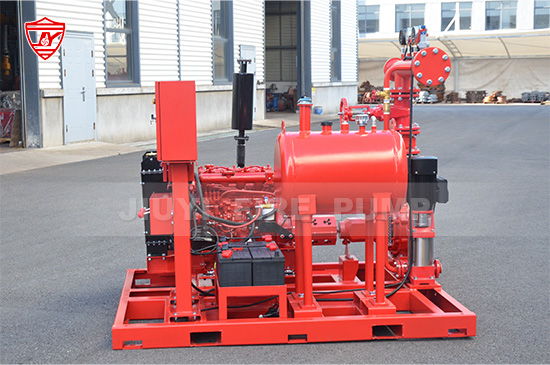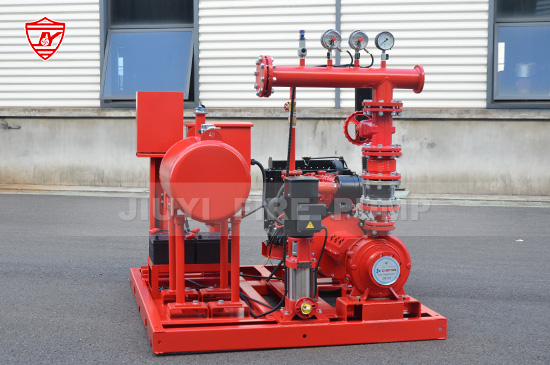Balancing flow and pressure is one of the most crucial aspects of maintaining a reliable and efficient fire pump system. An improperly balanced system can cause serious issues — from low water pressure during a fire emergency to damaged pipes and fittings due to excessive pressure. For engineers, installers, and facility managers in the fire protection field, understanding how to achieve this balance is essential to ensure compliance with NFPA 20 and long-term operational reliability.
In this article, we will explore what determines flow and pressure in fire pump systems, common causes of imbalance, and best practices to achieve and maintain optimal performance.

Flow refers to the amount of water the pump can deliver, typically measured in gallons per minute (GPM) or liters per second (L/s).
Pressure is the force with which that water is delivered, measured in pounds per square inch (PSI) or bar.
In a fire protection system, both parameters must meet specific design criteria based on building height, sprinkler layout, and hazard classification. According to NFPA 20, the fire pump must provide the required flow at a designated pressure to meet the system demand at the most remote hydrant or sprinkler head.
The relationship between flow and pressure is inversely proportional — when flow increases, pressure tends to decrease. The goal is not to maximize one at the expense of the other, but to find a balance that ensures adequate and consistent water delivery during all operational scenarios.
A well-balanced fire pump system ensures:
Reliable Fire Suppression – Adequate water flow and pressure guarantee that sprinklers and hydrants can perform effectively in an emergency.
System Longevity – Excessive pressure can cause premature wear or leaks in pipes, valves, and fittings.
Energy Efficiency – Proper balance prevents the pump from overworking, reducing energy consumption and maintenance costs.
Regulatory Compliance – Fire protection standards such as NFPA 20 and UL/FM certification require systems to perform within specific flow-pressure parameters.
If the balance is off, problems like cavitation, pressure surges, or insufficient flow can compromise both performance and safety.
Several factors can disturb the balance between flow and pressure in a fire pump system:
Improper Pump Selection
Selecting a pump with incorrect head or capacity is one of the most common mistakes. If the pump head is too high, it may produce excessive pressure at low flow conditions; if too low, it will fail to meet design requirements during demand peaks.
Friction Loss in Piping
Long pipe runs, small diameter pipes, or excessive fittings can increase friction loss, reducing available pressure at discharge points.
Elevation Differences
In high-rise buildings or multi-level facilities, elevation changes significantly affect pressure. For every 10 meters (33 feet) of elevation gain, pressure drops by about 1 bar (14.5 psi).
Blocked or Dirty Strainers
Clogged suction strainers or filters restrict water intake, reducing flow and causing the pump to operate under vacuum conditions that can lead to cavitation.
Air Leaks in Suction Line
Even a small air leak can drastically reduce suction efficiency, leading to fluctuating flow and unstable pressure.
Inaccurate Controller Settings
Incorrect settings in the fire pump controller or pressure relief valve may cause the pump to start or stop at improper pressure thresholds, destabilizing the system.
To maintain the right flow and pressure, it’s important to understand how each system component contributes:
Centrifugal Fire Pump – Converts mechanical energy into hydraulic energy; its impeller size and speed determine flow and pressure performance.
Pressure Relief Valve (PRV) – Prevents overpressure by discharging excess water when system pressure exceeds safe limits.
Pressure Reducing Valve (PRDV) – Controls downstream pressure to protect piping networks and end-use devices.
Jockey Pump – Maintains system pressure during minor leaks or small discharges without starting the main fire pump.
Pump Controller – Ensures automatic operation of the fire pump at preset pressure levels and sequences.
A proper combination and calibration of these components are critical to sustaining the desired hydraulic balance.
Achieving the correct balance involves a systematic approach — from design to commissioning and routine maintenance.
Start by calculating the required flow and pressure based on the building’s hazard level and layout. Follow NFPA 13 and NFPA 20 guidelines to determine design demand. Always consider elevation, pipe length, and fitting losses when sizing pumps.
Choose a pump whose rated flow and pressure match your system requirements at 150% of rated capacity (as per NFPA 20). For example, if your system requires 750 GPM at 100 PSI, ensure the pump can provide approximately 1125 GPM at a slightly lower pressure without exceeding motor limits.
Use PRVs and PRDVs to control high discharge pressures, especially in systems with varying elevation levels. This helps maintain consistent pressure across all zones.
A jockey pump automatically maintains system pressure during minor leaks. It should be sized at about 1–2% of the main pump’s capacity and adjusted to start before the main pump to avoid unnecessary cycling.
Routine testing ensures your pump operates as designed. Flow tests should verify performance at 100%, 150%, and 0% flow conditions. Compare results with the manufacturer’s performance curve — deviations may indicate wear, obstruction, or calibration issues.
Install accurate gauges at suction and discharge points. Modern fire pump controllers often integrate digital sensors to log real-time pressure data, helping identify anomalies before they escalate.
Inspect suction strainers, impellers, and bearings periodically. Clean or replace clogged components and recalibrate control settings to maintain efficiency and balance.
Even well-designed systems can experience imbalance due to wear or external conditions. Common troubleshooting steps include:
Low Pressure, Normal Flow: Check suction restrictions, impeller wear, or motor speed.
High Pressure, Low Flow: Verify discharge valve position, blocked piping, or oversized pump.
Fluctuating Pressure: Inspect for air leaks, damaged seals, or malfunctioning controllers.
No Flow: Ensure suction valves are open, strainers are clear, and the pump is primed.
Documenting and comparing readings from regular testing can help identify trends and prevent failures.
In larger installations such as high-rise buildings, multiple pumps often operate in parallel or series to meet variable flow and pressure requirements.
Parallel Pumps: Increase flow while maintaining the same pressure.
Series Pumps: Increase pressure for high-rise applications where water must reach upper floors.
Careful coordination of pump curves, check valves, and controllers ensures smooth transitions between pumps and prevents overpressure or cavitation when demand changes.
All fire pump systems must adhere to NFPA 20 (Standard for the Installation of Stationary Pumps for Fire Protection). Regular inspection and testing should also comply with NFPA 25 (Inspection, Testing, and Maintenance of Water-Based Fire Protection Systems).
Key recommendations include:
Weekly or monthly pump runs (depending on configuration)
Annual flow testing under rated and overload conditions
Periodic recalibration of controllers and sensors
Certification testing for UL/FM compliance when required
Following these standards not only maintains balance but also ensures the system is ready when needed most.

Balancing flow and pressure in a fire pump system is both a science and an art. It requires precise design, careful installation, and continuous monitoring to ensure reliable fire protection performance. A well-balanced system safeguards property, minimizes energy consumption, and meets stringent safety regulations like NFPA 20.
For fire protection professionals, understanding how to achieve this balance is vital — it’s what transforms a good fire pump system into a dependable one that performs flawlessly during emergencies.